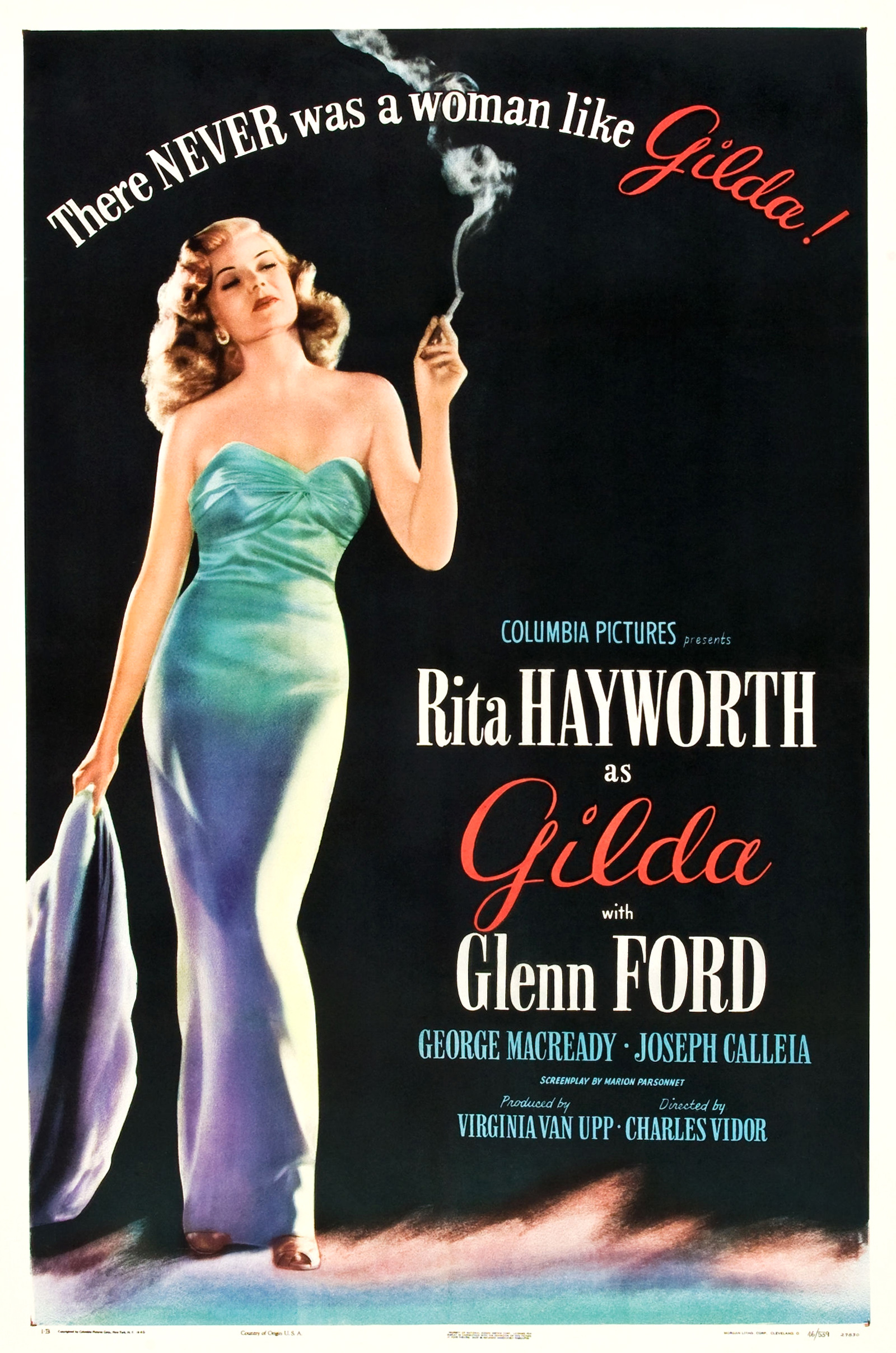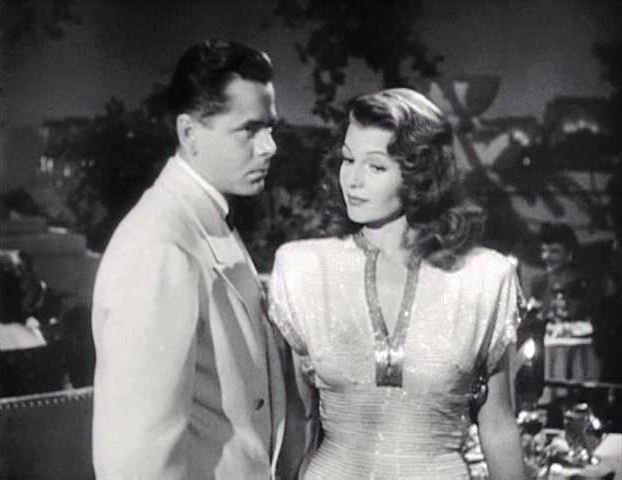
Year of release: 1946
Box office details: 3rd highest grossing title of the year.
DVD/VHS purchase: here.
Starring: Rita Hayworth, Glenn Ford
Studio: Columbia
Director: Charles Vidor
Costumes: Jean Louis
Plot Synopsis*:
Glenn Ford goes to work for the owner of an illegal South American gambling casino. When the owner returns with his new wife, Ford is given the assignment of keeping her faithful, only to be troubled by the fact that he and the wife had been lovers in the past.
Screen Life review:
 For me Rita Hayworth's sizzling performance as the definative femme fetale in the definative film noir inadvertantly came to life via Madonna's ultra decadent namecheck-rap on her slinky house jam Vogue. I researched every actress referenced and became more and more intrigued by the crimson screen pressence otherwise known as 'The Love Goddess'.
For me Rita Hayworth's sizzling performance as the definative femme fetale in the definative film noir inadvertantly came to life via Madonna's ultra decadent namecheck-rap on her slinky house jam Vogue. I researched every actress referenced and became more and more intrigued by the crimson screen pressence otherwise known as 'The Love Goddess'.
 Originating as little more than a B-movie, Gilda evolved daily into the star vehicle it eventually became. Hayworth began shooting her scenes without even a leading man cast, with new scenes being (re)written on the day of shooting. Glenn Ford would play opposite her for the 2nd out of 5 onscreen pairings: their hungry chemistry undeniable, his co-star slaps him and manages to shatter his teeth in one scene wherein he bravely doesn't let it show whilst the cameras are on. A unique bissexual love triangle is set in place with the phallic symbol belonging to her husband, the Nazi sympathiser Ballin (George Macready), both a sign of weakness and power. The tortured Gilda is the greedy and 'purchased' investment, whose hatred for Ford Ballin immediately recognises, 'hate is a very powerful emotion' is his sinister advice delivered with slithering menace veiled as a lover's whisper. The heroine takes her own turn at this line, this time tilting her head back in both classic cinematic femininity and evaluation of the effect of translating her sexuality into words whilst seemingly appearing to contradict herself using the seductive display of it. Her vivacious smoulder disguises her moments of vulnerabilty ('If I'd been a ranch, they would have named me the Bar Nothing').
Originating as little more than a B-movie, Gilda evolved daily into the star vehicle it eventually became. Hayworth began shooting her scenes without even a leading man cast, with new scenes being (re)written on the day of shooting. Glenn Ford would play opposite her for the 2nd out of 5 onscreen pairings: their hungry chemistry undeniable, his co-star slaps him and manages to shatter his teeth in one scene wherein he bravely doesn't let it show whilst the cameras are on. A unique bissexual love triangle is set in place with the phallic symbol belonging to her husband, the Nazi sympathiser Ballin (George Macready), both a sign of weakness and power. The tortured Gilda is the greedy and 'purchased' investment, whose hatred for Ford Ballin immediately recognises, 'hate is a very powerful emotion' is his sinister advice delivered with slithering menace veiled as a lover's whisper. The heroine takes her own turn at this line, this time tilting her head back in both classic cinematic femininity and evaluation of the effect of translating her sexuality into words whilst seemingly appearing to contradict herself using the seductive display of it. Her vivacious smoulder disguises her moments of vulnerabilty ('If I'd been a ranch, they would have named me the Bar Nothing').
 Rita's unforgettable scenes include her comical yet awe-inspiring hair tossing screen entrance and her musical 'clothed striptease' number Put The Blame On Mame. There is a good-girl ending tagged on at the end - blame censorship (in fact film noirs are often accused of misogyny: women were in fact being given meatier, darker roles to explore and censorship was yet to catch up is all I would argue briefly). So much heat burns out very quick, but the insatiable build up is pure gold.
Rita's unforgettable scenes include her comical yet awe-inspiring hair tossing screen entrance and her musical 'clothed striptease' number Put The Blame On Mame. There is a good-girl ending tagged on at the end - blame censorship (in fact film noirs are often accused of misogyny: women were in fact being given meatier, darker roles to explore and censorship was yet to catch up is all I would argue briefly). So much heat burns out very quick, but the insatiable build up is pure gold.
 Screen Life rating: 5/5
Screen Life rating: 5/5
Trivia:
Rita's vocals were dubbed by Anita Ellis. Studio boss Harry Cohn was never willing to invest in the time it would take to prepare Hayworth's own vocals using vocal lessons. The actress would eventually use her own voice in the 1971 when she made a well-publicised live appearances on Carol Burnett's highly successful comedy television series.
Box office details: 3rd highest grossing title of the year.
DVD/VHS purchase: here.
Starring: Rita Hayworth, Glenn Ford
Studio: Columbia
Director: Charles Vidor
Costumes: Jean Louis
Plot Synopsis*:
Glenn Ford goes to work for the owner of an illegal South American gambling casino. When the owner returns with his new wife, Ford is given the assignment of keeping her faithful, only to be troubled by the fact that he and the wife had been lovers in the past.
Screen Life review:
 For me Rita Hayworth's sizzling performance as the definative femme fetale in the definative film noir inadvertantly came to life via Madonna's ultra decadent namecheck-rap on her slinky house jam Vogue. I researched every actress referenced and became more and more intrigued by the crimson screen pressence otherwise known as 'The Love Goddess'.
For me Rita Hayworth's sizzling performance as the definative femme fetale in the definative film noir inadvertantly came to life via Madonna's ultra decadent namecheck-rap on her slinky house jam Vogue. I researched every actress referenced and became more and more intrigued by the crimson screen pressence otherwise known as 'The Love Goddess'. Originating as little more than a B-movie, Gilda evolved daily into the star vehicle it eventually became. Hayworth began shooting her scenes without even a leading man cast, with new scenes being (re)written on the day of shooting. Glenn Ford would play opposite her for the 2nd out of 5 onscreen pairings: their hungry chemistry undeniable, his co-star slaps him and manages to shatter his teeth in one scene wherein he bravely doesn't let it show whilst the cameras are on. A unique bissexual love triangle is set in place with the phallic symbol belonging to her husband, the Nazi sympathiser Ballin (George Macready), both a sign of weakness and power. The tortured Gilda is the greedy and 'purchased' investment, whose hatred for Ford Ballin immediately recognises, 'hate is a very powerful emotion' is his sinister advice delivered with slithering menace veiled as a lover's whisper. The heroine takes her own turn at this line, this time tilting her head back in both classic cinematic femininity and evaluation of the effect of translating her sexuality into words whilst seemingly appearing to contradict herself using the seductive display of it. Her vivacious smoulder disguises her moments of vulnerabilty ('If I'd been a ranch, they would have named me the Bar Nothing').
Originating as little more than a B-movie, Gilda evolved daily into the star vehicle it eventually became. Hayworth began shooting her scenes without even a leading man cast, with new scenes being (re)written on the day of shooting. Glenn Ford would play opposite her for the 2nd out of 5 onscreen pairings: their hungry chemistry undeniable, his co-star slaps him and manages to shatter his teeth in one scene wherein he bravely doesn't let it show whilst the cameras are on. A unique bissexual love triangle is set in place with the phallic symbol belonging to her husband, the Nazi sympathiser Ballin (George Macready), both a sign of weakness and power. The tortured Gilda is the greedy and 'purchased' investment, whose hatred for Ford Ballin immediately recognises, 'hate is a very powerful emotion' is his sinister advice delivered with slithering menace veiled as a lover's whisper. The heroine takes her own turn at this line, this time tilting her head back in both classic cinematic femininity and evaluation of the effect of translating her sexuality into words whilst seemingly appearing to contradict herself using the seductive display of it. Her vivacious smoulder disguises her moments of vulnerabilty ('If I'd been a ranch, they would have named me the Bar Nothing'). Screen Life rating: 5/5
Screen Life rating: 5/5Trivia:
Rita's vocals were dubbed by Anita Ellis. Studio boss Harry Cohn was never willing to invest in the time it would take to prepare Hayworth's own vocals using vocal lessons. The actress would eventually use her own voice in the 1971 when she made a well-publicised live appearances on Carol Burnett's highly successful comedy television series.
*plot synopsis is always copied and pasted.

Agen Judi QQ The Pkv 99 site is an agent listing the best pro pkv dominoqq games id and has become a trusted dealer this year which provides alternative links for qq gambling and even the name of online poker sites
ReplyDeleteSITUS PKV99
SITUS PKV 99
SITUS PKV99
SITUS PKV 99
SITUS PKV99
SITUS PKV 99
SITUS PKV99
SITUS PKV 99
SITUS PKV99
SITUS PKV 99
BERITAPKV.SITE Pkv News Will Give Tips and Tricks to Win Playing Pkv Games
ReplyDeleteBERITA PKV GAMES
TIPS DAN TRIK PKV GAMES
TRIK PKV GAMES
TRIK BANDARQ
TRIK PKV GAMES
TRIK PKV GAMES
TRIK PKV GAMES
TRIK PKV GAMES
TRIK PKV GAMES
TRIK PKV GAMES